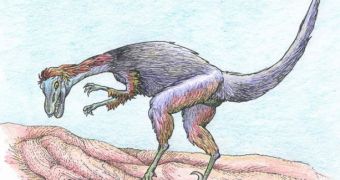In a strange twist, scientists recently managed to uncover the remains of a dinosaur that appears to have been killed off while searching for prey. The creature was most likely clawing at the ground, getting ready to unearth a buried “snack,” most likely a mammal. Dated back to 75 million to 80 million years ago, the scene most likely did not come to an end, as an event killed the dinosaur, burying and preserving it in the fossil record. The ancient depiction of how life must have looked like eons ago was unearthed in Utah, LiveScience reports.
“We found them about four years ago in July, in 100 degree F (37 degree C) heat. We had scorpions, rattlesnakes, and swarms of gnats,” says Kutztown University geologist and researcher Edward Simpson. He adds that the fossil was found between layers of sandstone, in an area of the state that is characterized by the presence of windblown dunes. The theropod dinosaur that produced the claw marks discovered by the scientists was not found on the scene.
By analyzing its trails, the team was able to determine that the creature was most likely 3 feet tall at the hips, and that it had a length of about 2 meters, or 6 feet. Paleontologists believe that the creature was most likely a relative of the famous Velociraptor, or of the lesser-known Deinonychus. The orientation of the marks shows that the lizard was trying to reach something. It's very likely that it followed a small mammal or a similar pray to this location, and then saw it disappear underground. Indeed, the fossilized burrows discovered by the team looked remarkably similar to shelters of mammalian, mouse-sized creatures, discovered elsewhere.
Considering that the claw and burrow fossils were not made thousands of years apart, “one can then ask why the dinosaurs might have been digging. If you eliminate other prospect – these aren't footprints, and they're not in symmetrical patterns as we've seen when raking aside earth for a nest – you're left with predatory actions. It's often hard to capture the behaviors of dinosaurs in the fossil record to see what they were doing. This is one of the few examples where one might see the impact of their behaviors, which is really cool,” explains Simpson.

 14 DAY TRIAL //
14 DAY TRIAL //